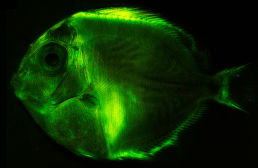Glow Baby Glow: Biofluorescence vs. Bioluminescence
Bioluminescence and Biofluorescence are two different naturally occurring phenomenon seen within certain organisms and generally involve the production or emission of light. Even though they are very similar, bioluminescence and biofluorescence are created differently and have a number of factors that make them distinct.
Bioluminescence is a chemical reaction created in the bodies of certain organisms and it’s similar to the reaction that occurs when you crack a glow stick. This reaction doesn’t produce a lot of heat so it is sometimes called “cold light”. The uses of this phenomenon are as varied as the types of creatures capable of producing it. Fireflies use their abilities to luminesce to blink in specific patterns to communicate with each other. Deep sea fish like the Angler fish use their bioluminescence to attract or mimic prey, and locate food. Other animals release bioluminescent fluid as a self-defense. There is still a lot to learn about this phenomenon and it is difficult to study due to the fact that animals usually lose their ability to luminescence when captured due to stress or damage during the capture process.
Biofluorescence on the other hand is not a chemical reaction, it is a phenomenon by which an organism absorbs blue light and emits it as a different color, usually red, orange or green. Until recently it was thought that only certain marine organisms like corals and jellyfish had the capability to fluoresce. Now, marine biologists have discovered that a wide distribution of fish also have this ability. It’s thought that this unusual occurrence is used primarily for communication, camouflage and mating purposes but new research suggests many additional functions and there is much more to discover about this phenomena. These new discoveries may one day be used to develop new products or even be used in the field of medicine to cure diseases!










